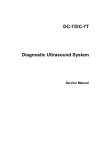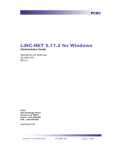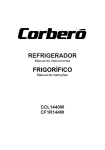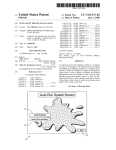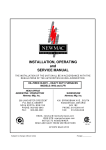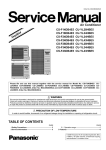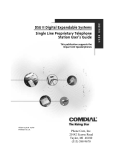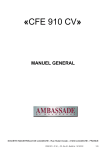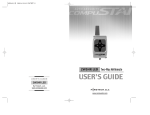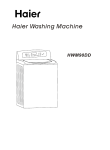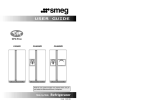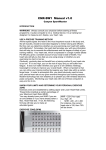Download Aire Acondicionado Conducto
Transcript
ES Manual de instalación Aire Acondicionado Conducto Modelos: MUC 12 HF MUC 18 HF MUC 24 HF MUC 30 HF MUC 36 HF MUC 48 HF MUC 60 HF Para realizar correctamente la instalación, lea este manual antes de empezar. El contenido de este manual puede estar sujeto a cambios sin notificación para la introducción de mejoras. Aire Acondicionado Conducto ES ÍNDICE 1. PRECAUCIONES....................................................................................................................................2 2. ACCESORIOS ........................................................................................................................................2 3. LUGAR DE INSTALACIÓN......................................................................................................................3 4. INSTALACIÓN DEL MANDO POR CABLE.............................................................................................4 5. INSTALACIÓN DE LA UNIDAD INTERIOR.............................................................................................4 6. INSTALACIÓN DE LA UNIDAD EXTERIOR .........................................................................................10 7. INSTALACIÓN DE LA TUBERÍA DE CONEXIÓN ................................................................................11 8. CONEXIÓN DEL TUBO DE DESAGÜE................................................................................................13 9. CONEXIONES ELÉCTRICAS ..............................................................................................................13 10. UNIDADES EXTERIORES..................................................................................................................18 11. PRUEBA DE FUNCIONAMIENTO......................................................................................................18 Aire Acondicionado Conducto ES 1. PRECAUCIONES DURANTE LA INSTALACIÓN PRECAUCIONES PARA LA INSTALACIÓN DEL MANDO A DISTANCIA • Para hacer una instalación correcta, lea antes este manual. • La instalación de la unidad debe confiarse a personas cualificadas. • Al instalar la unidad interior o sus conducciones, siga las instrucciones de este manual tan estrictamente como sea posible. • Cuando termine todos los trabajos de instalación, no conecte la alimentación eléctrica hasta no haber realizado una comprobación exhaustiva. • No se hará ningún nuevo aviso si se realiza alguna modificación de este manual a consecuencia de una mejora del producto. • Si el cable esta dañado debe ser reemplazado por el fabricante, un servicio técnico autorizado o por personal cualificado. • El aparato debe instalarse de acuerdo con la reglamentación nacional para instalaciones eléctricas. • No golpee ni deje caer el mando • Antes de instalarlo, asegúrese que el lugar elegido está dentro del espacio de recepción • El mando debe estar al menos a 1 m de distáncia de cualquier aparato de TV o sonido (para evitar interferencias) • No coloque el mando en un lugar expuesto a la luz solar directa o a una estufa u otra fuente de calor. • Cuando coloque las pilas, fíjese en que los polos positivo y negativo estén bien orientados. NOTA El instalador debe explicar a los usuarios el manejo adecuado del equipo y su mantenimiento, así como recordarles que lean y conserven los manuales de instalación y de usuario 2. ACCESORIOS Manual de instalación (1) Mando a distáncia (1) Aislante de los tubos (2) Tubo de descarga (1) Cinta adhesiva para sellado (1) ELIMINACIÓN DEL ELECTRODOMÉSTICO VIEJO. En base a la Norma europea 2002/96/CE de Residuos de aparatos Eléctricos y Electrónicos (RAEE), los electrodomésticos viejos no pueden ser arrojados en los contenedores municipales habituales; tienen que ser recogidos selectivamente para optimizar la recuperación y reciclado de los componentes y materiales que los constituyen, y reducir el impacto en la salud humana y el medioambiente. El símbolo del cubo de basura tachado se marca sobre todos los productos para recordar al consumidor la obligación de separarlos para la recogida selectiva. El consumidor debe contactar con la autoridad local o con el vendedor para informarse en relación a la correcta eliminación de su electrodoméstico viejo. Mando a distáncia y elementos Mando a distáncia (1) Base del mando (1) Tornillo del montaje (1) Pilas alcalinas (2) Manual del mando a distancia (1) 2 Aire Acondicionado Conducto ES 3. LUGAR DE INSTALACIÓN ANTES DE LA INSTALACIÓN 1. Elija el recorrido mejor para el traslado 2. Transporte la unidad conservando la mayor cantidad posible del embalaje original 3. Si instala la unidad sobre una parte metálica del edificio, debe aislarla eléctricamente de acuerdo con los reglamentos de aparatos eléctricos pertinentes Unidad interior • Hay que dejar espacio suficiente para la instalación y el mantenimiento. • El techo debe ser horizontal, y su estructura capaz de soportar el peso de la unidad. • No debe haber obstáculos para la salida y entrada de aire, y la influencia del aire exterior debe reducirse al mínimo. • El aire de salida ha de poder alcanzar todos los puntos de la habitación. • Los tubos de conexión y desagüe deben ser fáciles de extraer. • No debe haber radiación directa desde aparatos de calefacción. NOTA Condiciones contenidas en la Directiva 89/336/CEE sobre compatibilidad electromagnética Para evitar fluctuaciones durante el arranque del compresor (proceso técnico), la instalación debe cumplir las siguientes condiciones: 1. La conexión eléctrica de la unidad debe hacerse en el cuadro de distribución principal. La distribución debe ser de baja impedancia; normalmente, la impedancia precisa se alcanza con un fusible de 32 A. 2. No hay que conectar ningún otro equipo en la misma línea eléctrica. 3. Para que la instalación sea homologable en todos sus detalles, consulte el contrato con la compañía eléctrica por si contiene limitaciones relativas a productos tales como lavadoras, acondicionadores de aire u hornos eléctricos. 4. Vea los detalles relativos a la alimentación del acondicionador en la placa de características del producto. 5. Consulte cualquier duda al concesionario local. Unidad exterior • Hay que dejar espacio suficiente para la instalación y el mantenimiento. • No debe haber obstáculos para la salida y entrada de aire; la unidad no debe verse afectada por vientos fuertes. El emplazamiento debe ser seco y estar bien ventilado. • La superfície de apoyo debe ser plana y horizontal y capaz de soportar el peso de la unidad exterior. No debe haber otras fuentes de ruido o vibraciones. • Hay que asegurarse de que el ruido y el aire expulsado no molestan a los vecinos. • No debe haber fugas de gas combustible. • La instalación de los tubos y cables de conexión ha de ser fácil. IMPORTANTE Las condiciones descritas a continuación pueden afectar negativamente al funcionamiento de la máquina. (Si no hay otro remedio, consulte con el concesionario local) a. Presencia de derivados del petróleo b. Ambiente salino (cerca de la costa) c. Atmósfera con gases cáusticos (sulfuros, por ejemplo)(cerca de manantiales de aguas termales) d. Grandes oscilaciones de la tensión en la red (en fábricas) e. Espacios reducidos y cerrados f. Cocinas con gran cantidad de vapores de aceite g. Cerca radiaciones electromagnéticas potentes h. En presencia de materiales o gases inflamables i. En presencia de vapores o líquidos ácidos o alcalinos j. En otras condiciones especiales 3 Aire Acondicionado Conducto ES 4. INSTALACIÓN DEL MANDO POR CABLE A. NORMAS DE SEGURIDAD Por favor, lea estas normas de seguridad antes de la instalación. Respete todas las normas indicadas ya que son sumamente importantes. OTRAS PRECAUCIONES Lugar de instalación: No lo instale en un lugar con aceite, vapor o gas sulfuroso ya que se podría producir deformación y fallos. Significado de los avisos: PELIGRO: aviso de peligro de muerte o lesiones graves NOTA: aviso de lesiones o daños materiales Preparación antes de la instalación 1. Asegúrese de que se ha preparado lo siguiente. a. Mando por cable (1) b. Tornillo para madera (2) c. Tornillo para montaje (2) d. Manual de instalación (1) e. Manual de instrucciones (1) • Confirme que no existen fenómenos anormales durante la prueba de funcionamiento una vez realizada la instalación. Después, entregue el manual al usuario. • La instalación debe ser realizada por profesionales. Otras personas podrían realizar una instalación defectuosa con riesgo de descarga eléctrica o incendio. • Siga estas instrucciones de la forma más estricta posible.Una instalación incorrecta puede ocasionar descarga eléctrica o incendio. • No desmonte su aparato de aire acondicionado de forma desordenada. Un desmontaje aleatorio podría ocasionar un funcionamiento anormal o calentamiento y riesgo de incendio. 2. Preparar lo siguiente en el lugar de instalación a. Cable apantallado 5 conductores b. Caja de distribución c. Manguera de cables (manguito aislante y tornillo) Aviso para la instalación del mando por cable 1. Estas instrucciones contienen información sobre el procedimiento de instalación del mando. Consulte el manual de instalación de la unidad interior para la conexión entre el mando y dicha unidad. 2. El circuito del mando es de baja tensión. Nunca lo conecte a un circuito estándar de 220V/380V ni lo ponga en la misma manguera de cables que el circuito. 3. El cable apantallado debe estar conectado de forma estable a tierra, o podría fallar la transmisón. 4. No prolongue el cable apantallado cortándolo. Si fuese necesario use un bloque de conexión. 5. Una vez finalizada la conexión, no use un "Megger" para comprobar el aislamiento al cable de señal. NOTA • No instale el aparato en un lugar donde haya fugas de gas combustible. El gas combustible permanecerá cerca del mando, pudiéndose producir incendio • El cable debe ser adecuado para la intensidad del mando. De lo contrario podrían producirse fugas eléctricas o calor, con el correspondiente riesgo de incendio • El cable debe ser adecuado para el mando. No aplique fuerza externa en el terminal. De lo contrario, el cable se romperá o se calentará, con el correspondiente riesgo de incendio. 4 Aire Acondicionado Conducto ES 4. INSTALACIÓN DEL MANDO POR CABLE (artículo opcional) B. INSTALACIÓN INSTALACIÓN EN LA PARED • El diámetro del cable del mando debe ser adecuado a su longitud. • La manguera debe ser adecuada para los cables. • Para quitar la tapa, haga girar un destornillador en la parte cóncava del panel inferior del mando. INSTALACIÓN SOBRE LA PARED • Antes de la instalación, haga un orificio que permita el paso de un cable apantallado de 3 conductores con aislamiento de goma desde el centro de la tapa superior del mando. • Vea la instalación de la caja distribución para cualquier otra información que necesite. • Aplique sellador alrededor de los cables y en el orificio una vez finalizada la instalación. NOTA • No apriete demasiado los tornillos, ya que podría abollarse la tapa o romperse la pantalla. • No corte lo cables cuando instale la tapa del mando. NOTA • No apriete demasiado los tornillos, ya que podría abollarse la tapa o romperse la pantalla. • No corte lo cables cuando instale la tapa del mando. • Deje suficiente longitud de cable para el mantenimiento del control 5 Aire Acondicionado Conducto ES 6 Aire Acondicionado Conducto ES 5. INSTALACIÓN DE LA UNIDAD INTERIOR FORMA DE ANCLAR LOS PERNOS DE SUSPENSIÓN Instalación del cuerpo principal Instalación de los pernos de suspensión de Ø10 (4 pernos) Estructura de madera Coloque la tabla de madera transversalmente sobre las vigas y luego sujete los pernos de colgar (Figura 1) • Consulte en la siguiente figura la forma de medir la distancia entre los pernos • Utilice pernos para colgar de Ø10 • La forma de hacer la instalación del techo depende de la estructura; consulte los detalles a un especialista 1. El techo dónde vaya a instalar la máquina debe ser plano. Consolide las vigas del falso techo contra posibles vibraciones. Ladrillos de hormigón nuevos Anclaje de los pernos (Figura 2) 2. Corte la viga del falso techo 3. Refuerce el sitio cortado y consolide la viga del falso techo • Coloque las tuberías y la línea eléctrica por el techo después de montar el cuerpo principal. Antes de empezar a trabajar, determine la dirección que seguirán los tubos. Especialmente en el caso de un falso techo, coloque los tubos de refrigerante, desagüe y los cables eléctricos de las unidades interior y exterior hasta los puntos de conexión antes de colgar la máquina. Para ladrillos de hormigón originales Utilice pernos empotrados y herrajes de enganche (Figura 3) Estructura del techo de vigas de acero Instale y utilice directamente el angular de acero de soporte (Figura 4) Suspensión de la unidad interior (Figura 5) (1) Suspenda la unidad interior en los pernos de suspensión con el bloque. (2) Coloque la unidad interior nivelada usando el indicador de nivel, a menos que éste pueda producir fugas. 7 Aire Acondicionado Conducto ES POSICIÓN DEL ESPACIO DEL TECHO, UNIDAD INTERIOR Y PERNOS DE SUSPENSIÓN Capacidad (Btu/h) A B C D E F 9000-18000 874 910 - - - 19 9.53 24000 G H I J K L M N - 25 - - 260 - - 1000 1052 1112 1085 1470 19 9.53 252 24.5 580 290 430 1000 1052 1112 1085 1470 19 9.53 - 24.5 430 2 - 3 - 3 - 4 - 30000-48000 1350 1400 1380 1400 1430 19 9.53 252 35 1350 1400 1380 1400 1430 19 9.53 - 35 930 310 430 - 430 INSTALACIÓN DEL CUERPO PRINCIPAL AVISO Las figuras 7a y 7b están basadas en un modelo de 40000 Btu/h, por lo que podrían existir pequeñas diferencias de aspecto y funciones con su aparato. Cuando utilice una instalación con retorno posterior, por favor consulte la figura 8. Cuando curse el pedido, por favor explique claramente si el cliente necesita una embocadura de entrada de aire e indique si el retorno es horizontal o vertical. 8 Aire Acondicionado Conducto ES INSTALACIÓN DEL PANEL 1. Desempaquetar el soporte interior. Deslice el botón, suelte la hebilla del orificio del soporte exterior y después desempaquete el soporte interior. 5. Fije el cuerpo principal y el soporte exterior con el carril metálico de agujeros (en dos posiciones). • Cuelgue un lado del carril metálico de agujeros en el gancho del cuerpo principal. • Fije el otro lado del carril metálico con un tornillo al soporte exterior. • Corte la parte sobrante del raíl con unos alicates. • Doble la parte superior del extremo cortado. Figura 10 2. Suspenda el soporte exterior en el cuerpo principal mirando hacia abajo. (4 sitios en 4 esquinas). Cuelgue la correa en el gancho del cuerpo principal. Carril metálico de fijación NOTA Cuando cuelgue el soporte exterior con el raíl, y con la correa, presione fuerte el soporte exterior contra el techo y fijelo. 6. Instale el soporte interior en el soporte exterior (secuencia inversa al desembalaje del soporte interior). NOTA El cable de señal del receptor del mando a distancia debe salir a través del conducto de aire. NOTA Conecte el receptor del mando a distancia con los cables de señal de la unidad interior y fíjelo. 3. Fije el soporte exterior y el conducto de aire con tornillos. El tornillo se debe instalar de abajo arriba. 7. Instale el mando a distancia. 4. Cuelgue el soporte exterior hasta que esté firmemente adherido al techo. 9 Aire Acondicionado Conducto ES 6. INSTALACIÓN DE LA UNIDAD EXTERIOR IMPORTANTE • Mantenga la unidad protegida de la luz solar directa y de otras fuentes de calor. Si no hay otro remedio, cúbrala con una protección • En lugares próximos a la costa o muy altos, donde los vientos sean fuertes, instale la unidad contra la pared para asegurar un funcionamiento normal • Utilice un deflector en caso necesario • Si el viento es extraordinariamente fuerte, impida que circule hacia la parte trasera de la unidad (Figura 16) • Coloque la unidad exterior tan próxima a la interior como sea posible. Las distancias mínimas entre la unidad exterior y los obstáculos descritos en la figura de instalación no significan que no se pueda montar un cortavientos. Deje libres dos de las tres direcciones A,B,C. Figura 18 Transporte e instalación • Como el centro de gravedad de la unidad no coincide con el centro geométrico, tenga cuidado cuando levante con un elevador • No levante nunca agarrándola por la entrada de aire, pues se deformaría • No toque el ventilador con las manos ni con otros objetos • No la incline más de 45° grados, ni la apoye sobre un lado • Sujete las patas de la unidad con pernos para impedir que se caiga en caso de terremoto o de vientos fuertes • Disponga una base de hormigón (Figura 18) Figura 16 Espacio necesario para la instalación y el mantenimiento (Figura 17) Si es possible, retire los obstáculos próximos para evitar que el funcionamiento se degrade por falta de circulación de aire. Deje libres dos de las tres direcciones A,B,C. Figura 17 10 Aire Acondicionado Conducto ES 7. INSTALACIÓN DE LA TUBERIA DE CONEXIÓN Compruebe que la diferencia de alturas entre las unidades interior y exterior, la longitud del tubo de refrigerante y el número de codos, satisfacen los requisitos siguientes: Observaciones sobre la forma de doblar los tubos • El ángulo de doblez no debe superar los 90° • La posición del codo debe fijarse a ser posible en el tubo que va a doblarse. Cuanto mayor sea el codo, mejor. • No doble un tubo más de tres veces Máxima diferencia de alturas:........................10 m (Si la diferencia es superior a 10m, coloque la unidad exterior sobre la interior) Longitud del tubo refrigerante:........menos de 3 m Número de codos:.........................menos de 10 m Doble el tubo de conexión de pared más delgado • Corte una concavidad de la forma deseada en la parte del codo del tubo de aislamiento • Después la tubería (cúbrala con cinta después de doblar) • Para evitar que se apalste o se deforme, doble el tubo con el mayor radio posible • Utilice una herramienta especial si tiene que formar radios pequeños • Durante la instalación, evite que entre aire, polvo u otras impurezas dentro de los tubos. • El tubo de conexión no debe instalarse hasta no haber fijado las unidades interior y exterior. • Mantenga seco el tubo de conexión y evite que entre humedad durante la instalación Forma de conectar los tubos Mida la longitud necesaria de tuberia de conexión como se describe en los párrafos siguientes: a.Conecte primero la unidad interior y después la exterior • Doble la tubería correctamente. No la estropee. Uso del tubo de latón comercial Asegúrese de que utiliza los mismos materiales de aislamiento cuando compre el tubo de latón (más de 9 mm de espesor) Colocación del tubo a. Perfore un orificio en la pared (suficiente para el pasamuros, que suele tener 90 mm) y coloque después el pasamuros y su tapa. IMPORTANTE • Unte con aceite refrigerante la tubería abocardada y las tuercas de las juntas y dele 3 o 4 vueltas a mano antes de apretarlas con una llave (Figura 19) • Cuando conecte o desconecte las tuberías, use siempre dos llaves a la vez. b. Reúna los tubos de conexión y los cables y forme un haz apretado con cinta adhesiva. No deje que entre aire, pues podría producir goteo de agua por condensación b. La válvula de cierre de la unidad exterior debe estar completamente cerrada (en su estado original). Siempre que haga una conexión, afloje primero las tuercas de la parte de la válvula de cierre y conecte enseguida el tubo abocardado (en 5 minutos). Si las tuercas permanecen flojas durante mucho tiempo, puede entrar polvo o suciedad en el circuito y provocar más tarde una avería. Por ello, antes de la conexión, expulse el aire del tubo refrigerante c. Debe expulsar el aire (consulte vaciado del aire) después de conectar la conducción de refrigerante a las unidades interior y exterior. Apriete, después, las tuercas en los puntos de reparación. c. Pase los tubos unidos por el pasamuros desde el exterior para que el tubo de refrigerante que conecta las unidades interior y exterior tenga un flujo sin obstáculos. d. Use un detector o agua jabonosa para cercionarse que no hay fugas. e. Cubra la junta del tubo de conexión con la unidad interior con la funda aislante/anitruidos (accesorios) y sujétela bien con cinta adhesiva para evitar fugas. Figura 19 11 Figura 20 Figura 21 Aire Acondicionado Conducto ES Abocardado 1. Corte la tubería con un cortatubos. 2. Inserte en la tubería una tuerca para unión abocardada y dé a la tubería la forma abocardada. Diámetro exterior (mm) Ø6,35 Ø9,53 Ø12,7 Ø16 Ø19 5. Cuando haya terminado de bombear, cierre del todo la llave de baja de la válvula de colector y pare la bomba de vacío. • Cuando haya bombeado durante más de 15 minutos, confirme que el indicador del manovacuómetro señala 1,0 x 10-5 Pa (-76 cmHg). 6. Afloje y retire la tapa cuadrada de las válvulas de cierre A y B para abrirlas del todo; sujételas después. 7. Desmonte el latiguillo de la boca de reparación de la válvula de cierre A y apriete la tuerca. A (mm) Máx. 8,3 12,4 15,8 19,0 23,3 Máx. 8,3 12,0 15,4 18,6 22,9 Apriete las tuercas • Coloque la tubería de conexión en la posición adecuada, apriete las tuercas con la mano y después apriételas con una llave.(Figura 24) Figura 24 IMPORTANTE IMPORTANTE Un par de apriete excesivo dañará el abocardado; si es insuficiente, permitirá fugas. Determine el par de apriete en la tabla 2. Tamaño de la tubería Ø6,35 Ø9,53 Ø12,7 Ø16 Ø19 A Válvula de baja B Válvula de alta C, D Juntas de la tubería de conexión a la unidad interior. Par 1420~1720 N · cm (144~176kgf · cm) 3270~3990 N · cm (333~407kgf · cm) 4950~6030 N · cm (504~616kgf · cm) 6180~7540 N · cm (630~770kgf · cm) 9720~11860 N · cm (990~1210kgf · cm) Tabla 2 Extraiga el aire con una bomba de vacío (Figura 25) (Consulte en este manual la forma de utilización de la válvula de colector) 1. Afloje y retire las tuercas de mantenimiento de las válvulas de cierre A y B y conecte el latiguillo de la válvula de colector al terminal de mantenimiento de la válvula de cierre A (asegúrese de que las dos válvulas de cierre A y B están cerradas). 2. Conecte la junta del latiguillo a la bomba de vacío. 3. Abra del todo la llave de baja de la válvula de colector. 4. Ponga en marcha la bomba de vacío. Cuando comience el bombeo, afloje un poco la tuerca del terminal de mantenimiento de la válvula de cierre B para comprobar si entra el aire (cambia el ruido de la bomba y el indicador del manovacuómetro marca por debajo de cero). Después, apriete la tuerca. 12 Se deben abrir todas las válvulas de cierre antes de la prueba de funcionamiento. Todos los acondicionadores tienen dos válvulas de cierre de distintos tamaños en el lado de la unidad exterior que funcionan respectivamente como válvula de baja y válvula de alta. (Figura 26) CARGA AÑADIDA • Cuando la longitud de la tubería única es menor de 5 m, no es necesario añadir refrigerante después de purgar. • Cuando la longitud de la tubería única es de más de 5 m, hay que añadir la cantidad de refrigerante indicada a continuación (unidades en gramos): Longitud del Método de purga del aire tubo de conexión Cantidad extra de refrigerante que se debe cargar Menos de 8 m Utilice el refrigerante de la unidad exterior Más de 8 m Utilice la bomba de vacío 30 g (longitud, 5 m) (20000 btu/h.) o una botella de refrigerante 65 g (longitud, 5 m) (24000 btu/h.) Aire Acondicionado Conducto ES COMPROBACIÓN DE FUGAS Compruebe todas las juntas con el detector de fugas o con agua jabonosa. 9.CONEXIONES ELÉCTRICAS Conexiones 1. El acondicionador debe utilizar una línea independiente de la tensión especificada. 2. La alimentación eléctrica debe disponer de toma de tierra, que debe conectarse a las tomas correspondientes de las unidades interior y exterior. 3. Las conexiones debe realizarlas personal cualificado y siguiendo los esquemas eléctricos. 4. Hay que montar un protector de corrientes de fuga de conformidad con el reglamento eléctrico nacional 5. Asegúrese de colocar correctamente los cables de alimentación y señalización para evitar las interferencias y el contacto con el tubo de conexión o el cuerpo de la válvula de cierre. 6. El cable de conexión que viene con el acondicionador tiene 10 m. Si necesita uno más largo, asegúrese de elegir uno del mismo tipo. En general, no deben conectarse entre sí dos cables retorciendo las puntas; hay que soldarlos y protegerlos con cinta aislante 7. No conecte la alimentación antes de haber comprobado las conexiones que acaba de realizar. AISLAMIENTO • Asegúrese de cubrir con material aislante todas las partes expuestas de las juntas abocardadas y la tubería de refrigerante en los lados del líquido y del gas. Compruebe que están bien ajustados. • Un aislamiento incompleto puede causar condensación de agua. 8. CONEXIÓN DEL TUBO DE DESAGÜE 1. Instalación del tubo de desagüe de la unidad interior La salida tiene una rosca PTI; utilice materiales para sellado y fundas de tubos cuando conecte los tubos de PVC IMPORTANTE • El tubo de desagüe de la unidad interior debe aislarse térmicamente para evitar la condensación de humedad, al igual que las conexiones a dicha unidad. • Utilice adhesivo de PVC para conectar los tubos y asegúrese de que no hay fugas. • Tenga cuidado para no aplicar presión en el lado de los tubos de la unidad interior. • La pendiente descendente del tubo de desagüe debe ser de al menos 1/100, y el tubo no debe tener ondulaciones. • La longitud transversal total del tubo de desagüe no debe ser mayor de 20m; si este recorrido es largo, hay que colocar soportes para evitar que se doble. • Consulte las siguientes figuras para ver los detalles de instalación de los tubos. 2.Prueba del desagüe • Compruebe que el tubo de desagüe no está obtruido. • En edificios nuevos, esta prueba debe hacerse antes de montar el falso techo 13 Aire Acondicionado Conducto ES Características de la alimentación eléctrica 18000 18000 Btu/h Btu/h 24000 24000 Btu/h Btu/h 24000-30000 Btu/h Monofásico Monofásico Trifásico 220-240V - 50 Hz 220-240V - 50 Hz 380V 3N - 50 Hz 40/25 40/25 20/15 3 x 2.0 3 x 2,5 5 x 1,5 2,0 2,5 1,5 - 3 x 2,5 5 x 1,5 Señal electrica fuerte 5 x 2,0 3x2 5 x 1,0 Señal electrica débil 1 x 0,5 2 x 1,0 2 x 0,5 Tipo (frío Tipo (fríoyycalor) calor) Fases Alimentación Tensión Fusible (A) 2 Alimentación ud. Interior (mm ) Cable tierra Conexión de las unidades 2 interior/exterior (mm ) Alimentación ud. exterior 30000-36000 Btu/h 36000-48000 Btu/h 9000 Btu/h 12000-18000 Btu/h Monofásico Trifásico Monofasico Monofasico 220-240V - 50 Hz 380V 3N - 50Hz 220-240V - 50 Hz 220-240V - 50 Hz 40/25 20/15 40/25 40/25 3 x 3,5 5 x 2,5 3 x 2,0 3 x 2,0 3,5 2,5 2,0 2,0 3 x 3,5 5 x 2,5 - - 3 x 2,5 3 x 1,0 3 x 2,5 3 x 2,5 1 x 0,5 - - - 24000-36000 Btu/h 24000-30000 Btu/h 36000-48000 Btu/h Monofásico Trifásico Trifásico 220-240V - 50 Hz 380V3N - 50 Hz 380V 3N - 50 Hz 40/20 25/16 25/16 3 x 2.5 5 x 1,5 5 x 2,5 2,5 1,5 2,5 Alimentación ud. exterior 3 x 2,5 5 x 1,5 5 x 2,5 Señal electrica fuerte 1 x 1,0 2 x 1,0 1 x 1,5 Señal electrica débil - 2 x 0,5 - Tipo (frío y calor) Fases Alimentación Tensión Fusible (A) 2 Alimentación ud. Interior (mm ) Cable tierra Conexión de las unidades Alimentación ud. exterior 2 interior/exterior (mm ) Señal electrica fuerte Señal electrica débil Tipo (frío y calor) Fases Alimentación Tensión Fusible (A) 2 Alimentación ud. Interior (mm ) Cable tierra Conexión de las unidades 2 interior/exterior (mm ) PRECAUCIÓN Se debe incorporar un interruptor de conexión a la red según las normas vigentes de cada país 14 Aire Acondicionado Conducto ES DIAGRAMA DE CONEXIONES Conecte correctamente a tierra el acondicionador. De otro modo, las fugas a tierra podrían degradar el comportamiento antiparasitario de la unidad PRECAUCIÓN A continuación se muestra el diagrama de cableado tanto del modelo sólo frío como bomba de calor de la serie R410A. Al realizar las conexiones, por favor seleccione el diagrama correspondiente ya que, en caso contrario, se podrían producir averías. Figura 30 15 Aire Acondicionado Conducto ES 16 Aire Acondicionado Conducto ES 17 Aire Acondicionado Conducto ES 10. UNIDADES EXTERIORES Desmonte los tornillos de la tabla de mantenimiento y tire de ella en la dirección indicada por la flecha para retirarla . NOTA Tenga cuidado de no rayar la superficie al realizar esto. ATENCIÓN La figura 35 se basa en un tipo de unidad exterior que puede tener una apariencia diferente de la unidad exterior que usted ha adquirido. Figura 35 1) Compruebe lo siguiente en la unidad interior: a. El interruptor del mando a distancia funciona correctamente b. Los botones del mando a distancia funcionan bien c. El deflector del aire de salida se mueve normalmente d. Se ajusta bien la temperatura de la habitación e. El indicador se enciende normalmente f. Los botones del temporizador funcionan bien g. El desagüe funciona correctamente h. No hay vibraciones ni ruidos anormales durante el funcionamiento i. El acondicionador calienta bien si es del tipo CALOR-FRIO 11. PRUEBA DE FUNCIONAMIENTO 1. Cuando termine toda la instalación, debe hacer una prueba de funcionamiento 2. Confirme los puntos siguientes antes de efectuar la prueba: • Las unidades interior y exterior están correctamente instaladas • Los tubos y conexiones eléctricas están correctamente instalados • Se ha comprobado que no hay fugas en el sistema de tubos de refrigerante • El desagüe no presenta obstrucciones • El aislamiento térmico funciona bien • La conexión a tierra está bien hecha • Se ha tenido en cuenta la longitud de los tubos y la mayor capacidad de refrigerante • La tensión de la alimentación coincide con la especificada para el equipo • Las entradas y salidas de aire de las unidades interior y exterior no están obstaculizadas • Las válvulas de cierre de los lados de gas y líquido están abiertas • Se ha precalentado el acondicionador conectando la alimentación eléctrica 2)Compruebe lo siguinete en la unidad exterior: a. No se producen vibraciones o ruidos anormales durante el funcionamiento b. La salida de aire, el ruido o el agua condensada que se producen no molestan a los vecinos c. No hay fugas de refrigerante IMPORTANTE Una función de protección impide que la unidad arranque durante los 3 minutos siguientes a una parada. 3. Instale el soporte del mando a distancia según las indicaciones del usuario, donde su señal pueda llegar a la unidad interior. 4. Prueba de funcionamiento Coloque el acondicionador en el modo de REFRIGERACIÓN con el mando a distancia, y compruebe los puntos siguientes de acuerdo con el Manual del usuario. Si algo no funciona bien, corríjalo siguiendo las sugerencias del capítulo Averías y sus causas del Manual del usuario. 18 ES Manual de instalación ® SALVADOR ESCODA S.A. BARCELONA - Central Ventas: Provença, 392, plantas 1 y 2 - 08025 BARCELONA Tel. 93 446 27 80 - Fax 93 456 90 32 [email protected] www.salvadorescoda.com BARCELONA - T. BCN Centro: Rosselló, 430-432 bjs. 08025 Barcelona Tel. 93 446 20 25 Fax 93 446 21 91 ALMERÍA - Delegación: c/. Carrera del Doctoral, 22 ALMERÍA Próxima apertura Marzo 2007 MADRID 1 - Delegación: Av. de Castilla, 26 naves 10-11 28830 S. Fernando de Henares Tel. 91 675 12 29 Fax 91 675 12 82 SEVILLA 1 - Delegación: Joaquín S. de la Maza, PICA p. 170, m. 6-7-8. CP 41007 Tel. 95 499 97 49 Fax 95 499 99 14 BADALONA - T. BCN Norte: Industria 608-612 08918 Badalona Tel. 93 460 75 56 Fax 93 460 75 71 CÁDIZ - Delegación: Pol. El Portal, c/. Sudáfrica s/nº P. E. Mª Eugenia, 1. 11408 Jerez Tel. 956 35 37 85 Fax 956 35 37 89 MADRID 2 - Delegación: Fragua, 8 - Pol. Ind. Cantueña 28944 Fuenlabrada (Madrid) Tel. 91 642 35 50 Fax 91 642 35 55 SEVILLA 2 - Delegación: PIBO, Av. Valencina p. 124-125 41110 Bollullos Mitación Tel. 95 577 69 33 Fax 95 577 69 35 HOSPITALET - Tienda BCN Sur: Av. Mare de Déu de Bellvitge, 246-252 08907 L'Hospitalet Ll. Tel. 93 377 16 75 Fax 93 377 72 12 CASTELLÓN - Delegación: Av. Enrique Gimeno, 24 Pol. C. Transporte. CP 12006 Tel. 96 424 72 11 Fax 96 424 72 03 MADRID 3 - Tienda: Av. Emperatriz Isabel, 19 28019 Madrid Tel. 91 469 14 52 Fax 91 469 10 36 TARRAGONA - Delegación: c/. del Ferro, 18-20 Pol. Riu Clar. 43006 Tarragona Tel. 977 20 64 57 Fax 977 20 64 58 BARBERÀ - Tienda Vallès: Marconi, 23 08210 Barberà del Vallès Tel. 93 718 68 26 Fax 93 729 24 66 CÓRDOBA - Delegación: Juan Bautista Escudero, 219 C Pol. Las Quemadas. CP 14014 Tel. 957 32 27 30 Fax 957 32 26 26 MÁLAGA - Delegación: c/. Brasilia, 16 - Pol. El Viso 29006 Málaga Tel. 952 04 04 08 Fax 952 04 15 70 VALENCIA 1 - Delegación: Río Eresma, s/n.º 46026 Valencia Tel. 96 395 62 64 Fax 96 395 62 74 MATARÓ - Tienda Maresme: Polígono Ind. Plà d'en Boet Carrasco i Formiguera, 29-35 08302 Mataró Tel. 93 798 59 83 GIRONA - Delegación: c/. Alacant, 47 nave B Pol. Can Xirgú - 17005 Girona Tel. 972 40 64 65 Fax 972 40 64 70 MURCIA 1 - Delegación: Cuatro Caminos, 56 30007 Murcia Tel. 968 23 65 28 Fax 968 20 43 91 VALENCIA 2 - Delegación: P. I. nº 7, c/.Brosquil, n. III-IV 46540 El Puig (Valencia) Tel. 96 147 90 75 Fax 96 147 90 52 ALBACETE - Delegación: Pol. Campollano, D, p. 8-10 02007 Albacete Tel. 967 19 21 79 Fax 967 19 22 46 GRANADA - Delegación: Pol. Juncaril, c/. Lanjarón, 10 18220 Albolote (Granada) Tel. 958 49 10 50 Fax 958 49 10 51 MURCIA 2 - Delegación: Pol. Oeste, Principal, p. 21/10 30169 San Ginés (Murcia) Tel. 968 88 90 02 Fax 968 88 90 41 VALENCIA 3 - Delegación: Parque Empresarial Tactica c/. 2A, nº 10. 46980 Paterna Tel. 96 134 52 47 Fax 96 134 52 48 ALICANTE 1 - Delegación: Artes Gráficas, 10-12 03008 Alicante Tel. 96 511 23 42 Fax 96 511 57 34 JAÉN - Delegación: Pol. Olivares, Cazalilla, p. 527 23009 Jaén Tel. 953 28 03 01 Fax 953 28 03 46 PALMA DE MALLORCA - Del.: c/. Gremi de Boneters Pol. Son Castelló - CP 07009 Tel. 971 43 27 62 Fax 971 43 65 35 ZARAGOZA - Delegación: Polígono Argualas, nave 51 50012 Zaragoza Tel. 976 35 67 00 Fax 976 35 88 12 ALICANTE 2 - Delegación: c/. Metal·lurgia, Pol. Les Galgues 03750 Pedreguer (Alicante) Tel. 96 645 67 55 Fax 96 645 70 14 LLEIDA - Delegación: Pol. Segrià, N-230, km 7,4 25123 Torrefarrera (Lleida) Tel. 973 75 06 90 Fax 973 75 06 95 REUS - Delegación: Víctor Català, 46 43206 Reus (Tarragona) Tel. 977 32 85 68 Fax 977 32 85 61 REPRESENTACIONES: 985 36 21 28 Asturias 924 33 07 18 Mérida Pontevedra 986 86 07 76 EN Installation Manual Air Conditiones Duct type Model: MUC 12 HF MUC 18 HF MUC 24 HF MUC 30 HF MUC 36 HF MUC 48 HF MUC 60 HF For correct installation, read this manual before starting installation. This manual may be subject to change without notice for purpose of improvement.. Air Conditioner Duct Type EN CONTENT 1. INSTALLATION INFORMATION..............................................................................................................2 2. ACCESSORIES.......................................................................................................................................2 3. CAUTION ON REMOTE CONTROLLER INSTALLATION.......................................................................2 4. INSTALLATION PLACE...........................................................................................................................3 5. INDOOR UNIT INSTALLATION...............................................................................................................4 6. INSTALL THE CONNECTING PIPE........................................................................................................7 7. CONNECT THE DRAIN PIPE.................................................................................................................9 8. WIRING.................................................................................................................................................10 9. OUTDOOR UNIT...................................................................................................................................14 10. TEST OPERATION..............................................................................................................................14 Air Conditioner Duct Type EN 1. INSTALLATION INFORMATION • To install properly, please read this manual at first. The air conditioner must be installed by qualified persons. • When installing the indoor unit or its tubing, please follow this manual as strictly as possible. • When all the installation work is finished, please turn on the power only after a thorough check. • No further announcement if there is any change of this manual caused by product improvement. NOTE The installor should illustrate to users how to correctly use and maintain the air-conditioner, as well as remind users to carefully read and keep both Installation Manual and Owner's Manual well. 2. ACCESORIES Installation manual (1) Remote controller subassembly (1) Pipe insulation material (2) Accessory drain pipe (1) Adhesive tape for seal (1) Remote controller & its frame 1. Remote controller (1) 2. Frame (1) 3. Mounting screw (2) 4. Alkaline dry batteries (AM4)(2) 5. Remote controller manual (1) 3.CAUTIONS ON REMOTE CONTROLLER INSTALLATION • Never throw or beat the controller. • Before installation, operate the remote controller to determine its location in a reception range. • Keep the remote controller at least 1mapart from the nearest TV set or stereo equipment. (It is necessary to prevent image disturbances or noise interferences.) • Do not install the remote controller in a place exposed to direct sunlight or close to a heating source, such as a stove. • Note that the positive and negative poles are in right positions when loading batteries. 2 Air Conditioner Duct Type EN NOTES BEFORE INSTALLATION 1. Select the correct carry-in path. 2. Move this unit as originally packaged as possible. 3. If the air conditioner is installed on a metal part of the building, it must be electrically insulated according to the relevant standards to electrical appliances 4. INSTALLATION PLACE The Indoor Unit • There is enough roomfor installation and maintenance. • The ceiling is horizontal, and its structure can endure the weight of the indoor unit. • The air outlet and the air inlet are not impeded, and the influence of external air is the least. • The air flow can reach throughout the room. • The connecting pipe and drainpipe could be extracted out easily. • There is no direct radiation fromheaters NOTE Remark per EMC Directive 89/336/EEC For to prevent flicker impressions during the start of the compressor (technical process), following installation conditions apply. The Outdoor Unit • There is enough room for installation and maintenance. • The air outlet and the air inlet are not impeded, and can not be reached by strong wind. • The place is dry and ventilative. • The support is flat and horizontal and can stand the weight of the outdoor unit. And no additional noise or vibration. • Your neighborhood will not feel uncomfortable with the noise or expelled air. • There is no leakage of combustible gas. • It is easy to install the connecting pipe or cables. 1. The power connection for the air conditioner has to be done at the main power distribution. The distribution has to be of a low impedance, normally the required impedance reaches a 32Afusing poinat t. 2. No other equipment has to be connected with this power line. 3. For detailed installation acceptance, please refer to your contract with the power supplier if restrictions do apply for products like washing machines, air conditioners or electrical ovens. 4. For power details of the air conditioner, refer to the rating plate of the product. 5. For any question contact your local dealer. CAUTIONS Location in the following places may cause malfunction of the machine. (If unavoidable, please consult your local dealer.) a. There exists petrolatum. b. There is salty air surrounding(near the coast). c. There is caustic gas(the sulfide, for example) existing in the air (near a hot spring). d. The Volt vibrates violently(in the factories). e. In buses or cabinets. f. In kitchen where it is full of oil gas. g. There is strong electromagnetic wave existing. h. There are inflammable materials or gas. i. There is acid or alkaline liquid evaporating. j. Other special conditions. 3 Air Conditioner Duct Type EN THE INSTALLATION OF HANGING SCREW BOLTS: 5. INDOOR UNIT INSTALLATION Install the main body Installingf10 hanging screw bolts. (4 bolts) Please refer to the following figure for the distance measurement between the screw bolts. Please install with 10 hanging screw bolts. The handling to the ceiling varies fromthe constructions, consult the construction personnels for the specific procedures. Wooden construction Put the square timber traversely over the roof beam, then install the hanging screw bolts. (Refer to Chart 1) 1. The ceiling where the works will be done must be flat. Consolidate the roof beamfor possible vibration. 2. Cut off the roof beam. 3. Strengthen the place cut off, and consolidate the roof beam. New concrete bricks Inlaying or embedding the screw bolts. (Refer to Chart 2) Carry out the pipe and line operation in the ceiling after finishing the installation of the main body. While choosing where to start the operation, determine the direction of the pipes to be drawn out. Especially in case there is a ceiling, position the refrigerant pipes, drain pipes, indoor & outdoor lines to the connection places before hanging up the machine. The installation of hanging screw bolts. For Original concrete bricks Use embedding screw bold, crock and stick harness. (Refer to Chart 3) Steel roof beamstructre Install and use directly thesupporting angl steel. (Refer to chart 4) OVERHANGING THE INDOOR UNIT (1)Overhang the indoor unit onto the hanging screw bolts with block (2) Position the indoor unit in a flat level by using the level indicator, unless it may cause leakage. 4 Air Conditioner Duct Type EN INSTALLING THE DUST PROOF NET AND CANVAS AIR PASSAGE 1. Install the dust proof net according to the installation manual. 2. Install the canvas air passage underneath the dust proof net. Pipe Connection The static pressure in the outside of the unit is 39.2Pa (maximum98Pa), the length of the air pipe attached is determined by this parameter. THE POSITIONING OF CEILING HOLE AND INDOOR UNIT AND HANGING SCREW BOLTS Capacity (Btu/h) A M N 18000 1000 1050 1030 1050 1080 12,7 6,35 252 24,4 290 290 1 2 B C D E F G H I J K 24000-30000 1000 1050 1030 1050 1080 16 9.53 252 24.4 580 290 2 3 30000-48000 1350 1400 1380 1400 1430 19 12,7 252 35 4 INSTALL THE MAIN BODY 930 310 3 NOTICE This chart is based on 40000Btu/h type, So, a little differences may exist on the outlook and functions fromyours. When using a back-air installation, please refer to the following: Please explain clearly when ordering if customers need air inlet box. And note it is below air inlet or back air-inlet. 5 Air Conditioner Duct Type EN PANEL INSTALLATION 5. Fix the main body and the outside frame with the fix board of waist-shape hole (in two places) • Hang one side of the fix board of the waistshaped hole on the hook of the main body. • Tighten the other side of the board with screw to the outside frame. • Cut off the surplus part of the board with pliers. • Bend the top of the broken end. 1. Unload inner frame. Slide the knob, release the buckle fromthe outside frame hole, then unload the inner frame. 2. Hang the outside frame on the main body with face down. (4 places at 4 corners). Hang the belt on the hook of the main body. NOTE When hanging up the outside frame with the fix board of waist-shaped hole and the belt, stick the outside frame tightly to the ceiling and fix it. NOTE The signal wire of the remote control receiver must be drawn out through the canvas air passage. 3. Fix the outside frame and the canvas air passage with screws. Screw must be fixed on from the bottom to the top. 6. Install the inner frame on the outside frame (the inverse sequence of unloading the inner frame). NOTE Connect the remote control receiver with the indoor unit signal wires and fix it. 7. Install remote controller. 4. Hang up the outside frame until it sticks to the ceiling tightly. 6 Air Conditioner Duct Type EN 6. INSTALL THE CONNECTING PIPE CAUTION Check whether the height drop between the indoor unit and outdoor unit, the length of refrigerant pipe, and the number of the bends meet the following requirements: NOTICE FOR BENDABLE PIPE • The bending angle should not exceed 90 . • Bending position is preferably in the middle of the bendable pipe. The larger the bending radius the better it is. • Do not bend the pipe more than three times. The max height drop........................................20m (If the height drop is more than 10m, you had better put the outdoor unit over above the indoor unit) The length of refrigerant pipe............less than 30m The number of bends...........................less than 15 BEND THE CONNETCTING PIPE OF SMALL WALL THICKNESS • Cut out a desired concave at the bending part of the insulating pipe. • Then expose the pipe (cover it with tapes after bending). • To prevent collapsing or deforming, please bend the pipe at its biggest radius. • Use bender to get a small radius pipes. CAUTION • Do not let air, dust, or other impurities fall in the pipe systemduring the time of installation. • The connecting pipe should not be installed until the indoor and outdoor units have been fixed already. • Keep the connecting pipe dry, and do not let moisture in during installation. Use the market brass pipe Be sure to use the same insulating materials when you buy the brass pipe (more than 9mmthick). CONNECT THE DRAIN PIPE Measure the necessary length of the connecting pipe, and make it by the following way. 1) Connect the indoor unit at first, then the outdoor unit.Bend the tubing in proper way. Do not harm to them. 1. Locate The Pipes 1) Drill a hole in the wall (suitable just for the size of the wall conduit, 90mmin general), then set on the fittings such as the wall conduit and its cover. 2) Bind the connecting pipe and the cables together tightly with binding tapes. Do not let air in, which will cause water leakage by condensation. 3) Pass the bound connecting pipe through the wall conduit fromoutside. Be careful of the pipe allocation to do no damage to the tubing. 4) Connect the pipes. 5) Then, open the stemof stop valves of the outdoor unit to make the refrigerant pipe connecting the indoor unit with the outdoor unit fluently flow. 6). Be sure of no leakage by checking it with leak detector or soap water. 7). Cover the joint of the connecting pipe to the indoor unit with the soundproof/insulating sheath (fittings), and bind it well with the tapes to prevent leakage. CAUTION Daub the surfaces of the flare pipe and the joint nuts with frozen oil, and wrench it for 3~4 rounds with hands before fasten the flare nuts. (Refer to chart 16) Be sure to use two wrenches simultaneously when you connect or disconnect the pipes. 2) The stop value of the outdoor unit should be closed absolutely (as original state). Every time you connect it, first loosen the nuts at the part of stop value , then connect the flare pipe immediately (in 5 minutes). If the nuts have been loosened for a long time, dusts and other impurities may enter the pipe systemand may cause malfunction later. So please expel the air out of the pipe with refrigerant (R407C) before connection. 3) Expel the air (refer to the "Expel The Air") after connecting the refrigerant pipe with the indoor unit. Then fasten the nuts at the repair-points. Figura 16 7 Figura 17 Figura 18 Air Conditioner Duct Type EN The necessary filling amount of refrigerant When the length of the one-way pipe is under 5m, the quantity of filling fluorine will be subject to the nameplate. When the length of the one-way pipe is over 5m, the quantity to be added is as follows: Capacity ≤ 20000 Btu/h: 0.03x(L-5) (Unit: kg) Capacity ≤ 24000 Btu/h: 0.065x(L-5) (Unit: kg) L: The length of the pipe Please record the quantity added and store it carefully for future maintenance. Expel the air Flaring Chart 19 Chart 20 1. Cut a pipe with a pipe cutter. 2. Insert a flare nut into a pipe and flare the pipe. Outside-diameter (mm) Expel the air with a vacuumpump (Refer to Chart 22) (please refer to its manual for the way of using manifold value) • Loosen and remove the maintenance nuts of stop values Aand B, and connect the charge hose of the manifold value with the maintenance terminator of stop valueA. (Be sure Chart 22 that stop values A and B are both closed) • Connect the joint of the charge hose with the vacuumpump. • Open the Lo-lever of the manifold value completely. • Turn on the vacuum pump. At the beginning of pumping, loosen the maintenance terminator nut of stop valueB a little to check whether the air comes in (the sound of the pump changes, and the indicator of compound meter turns below zero). Then fasten the nut. • When the pumping has finished, close the Lolever of the manifold value completely and turn off the vacuum pump. When you have pumped for over 15 minutes, please confirm that the indicator of multi-meter is on 1.0x10-5 Pa(-76cmHg). • Loosen and remove the quadrangle cover of stop values Aand Bto open stop value Aand B completely, then fasten them. • Disassemble the charge hose fromthe repairmouth of stop value A, and fasten the nut. A(mm) Ø6.35 Ø9.53 Ø12.7 Ø16 Ø19 Max Min 8.7 12.4 15.8 19.0 23.3 8.3 12.0 15.4 18.6 22.9 Fasten the nuts Put the connecting tubing at the proper position, wrench the nuts with hands, then fasten it with a wrench.( Refer to Chart 21) Chart 21 CAUTION Too large torque will harm the bellmouthing and too small will cause leakage. Please determine the torque according to Table 2. Tubing Size Ø9.53 Ø19 Torque 15~18 N.m 35~40 N.m Table2 CAUTION All the stop values should be opened before test operation. Each air conditioner has two stop values of different sizes on the side of the outdoor unit which operate as Lo-stop value and Hi-stop value, respectively. 8 Air Conditioner Duct Type EN Check the leakage Check all the joints with the leak detector or soap water. 7. CONNECT THE DRAIN PIPE 1. Install indoor unit drain pipe The outlet has PTI screw bread, Please use sealing materials and pipe sheath (fitting) when connecting PVC pipes. Insulation Be sure to with insulating materials cover all the exposed parts of the flare pipe joints and refrigerant pipe on the liquid-side and the gasside. Ensure that there is no gap between them. Incomplete insulation may cause water condensation. Chart 23 A: Lo-Stop valve B: Hi-Stop valve C,D: Joints of the connecting pipe to the indoor unit CAUTION • The drain pipe of indoor unit must be heat insulated, or it will condense dew, as well as the connections of the indoor unit. • Hard PVC binder must be used for pipe connection, and make sure there is no leakage. • With the connection part to the indoor unit, please be noted not to impose pressure on the side of indoor unit pipes. • When the declivity of the drain pipe downwards is over 1/100, there should not be any win ding. • The total length of the drain pipe when pulled out traversely shall not exceed 20m, when the pipe is over long, a prop stand must be installed to prevent winding. • Refer to the figures on the right for the installation of the pipes. 2. Drainage test Check whether the drainpipe is unhindered New built house should have this test done before paving the ceiling. Remove the test cover, and stow water of about 2000ml to the water receiver through the stow tube. (Refer to chart 24) Chart 24 (Take 36000 Btu/h as example) 9 Air Conditioner Duct Type EN 8. WIRING Attaching wiring 5. Be sure to locate the power wiring and the signal wring well to avoid cross-disturbance and their contact with connecting pipe or stop value body. 6. The wiring attached to this air conditioner is 10m long. Be sure to prolong it with wiring of the same type and proper length if necessary. Generally, do not twist two wiring together unless the joint is soldered well and covered with insulator tape. 7. Do not turn on the power until you have checked carefully after wiring. 1. The air conditioner should use separate power supply with rated voltage 2. The external power supply to the air conditioner should have ground wiring, which is linked to the ground wiring of the indoor and outdoor unit. 3. The wiring work should be done by qualified persons according to circuit drawing. 4. Aleakage protector should be installed according to the National Standard concerning electrical appliance. The Specification of Power Type 18000 Btu/h 24000 Btu/h 24000-30000 Btu/h 1-Phase 1-Phase 3-Phase 220-240V - 50 Hz 220-240V - 50 Hz 380V 3N - 50 Hz 40/25 40/25 20/15 3 x 2,0 3 x 2,5 5 x 1,5 2,0 2,5 1,5 - 3 x 2,5 5 x 1,5 Storng electric signal 5 x 2,0 3 x 1,0 3 x 1,0 Weak electric signal 1 x 0,5 (1 core shield wire) 1 x 0,5 (2 core shield wire) 2 x 0,5 (2 core shield wire) 30000-36000 Btu/h 36000-48000 Btu/h 18000 Btu/h 1-Phase 3-Phase 1-Phase 220-240V - 50 Hz 380V 3N - 50 Hz 220-240V - 50 Hz 40/25 20/15 40/25 3 x 3,5 5 x 2,5 3 x 2,0 3,5 2,5 2,0 Outdoor unit power 3 x 3,5 5 x 2,5 - Storng electric signal 3 x 2,5 3 x 1,0 3 x 2,0 Weak electric signal 1 x 0,5 (1 core shield wire) - - 24000-36000 Btu/h 24000-30000 Btu/h 36000-48000 Btu/h 1-Phase 3-Phase 1-Phase 220-240V - 50 Hz 380V 3N - 50 Hz 220-240V - 50 Hz 40/20 25/16 25/16 3 x 2,5 5 x 1,5 5 x 2,5 Phase Power Frequency and volt Circuit breaker / Fuse (A) 2 Indoor unit power wiring(mm ) Ground wiring Indoor/Outdoor connecting wiring 2 (mm ) Outdoor unit power Type Phase Power Frequency and volt Circuit breaker / Fuse (A) 2 Indoor unit power wiring(mm ) Ground wiring Indoor/Outdoor connecting wiring 2 (mm ) Type Phase Power Frequency and volt Circuit breaker / Fuse (A) 2 Indoor unit power wiring(mm ) Ground wiring Indoor/Outdoor connecting wiring 2 (mm ) 2,5 1,5 2,5 Outdoor unit power 3 x 2,5 5 x 1,5 5 x 2,5 Storng electric signal 1 x 1,0 2 x 1,0 1 x 1,5 Weak electric signal - 2 x 0,5 - 10 Air Conditioner Duct Type EN WIRING CHART Installing wiring chart, refer to link circuit chart for details. Grounding the air conditioner properly in case to affect its anti-inteference function CAUTION The wiring chart of both cooling only type and cooling & heating type in R407Cand R410A series are shown as follows.When wiring, please choose the corresponding chart,or it may cause damage. Figura 25 11 Air Conditioner Duct Type EN 12 Air Conditioner Duct Type EN 13 Air Conditioner Duct Type EN 9.THE OUTDOOR UNITS Disassemble the bolts fromthe maintenance board, and pull it in the direction of the arrow to remove the protection board. NOTICE Do not scratch the surface during operation ATTENTION Chart 33 is based on one type of outdoor units, which may look different from your own outdoor unit. Chart 33 10. TEST OPERATION 1.The test operation must be carried out after the entire installation has been completed. 2. Please confirm the following points before the test operation: 3. According to the user's requirement, install the remote controller frame where the remote controller's signal can reach the indoor unit smoothly. 4. Test operation • The indoor unit and outdoor unit are installed properly. • Tubing and wiring are correctly completed. • The refrigerant pipe systemis leakage-checked. • The drainage is unimpeded. • The heating insulation works well. • The ground wiring is connected correctly. • The length of the tubing and the added stow capacity of the refrigerant have been recorded. • The power voltage fits the rated voltage of the air conditioner. • There is no obstacle at the outlet and inlet of the outdoor and indoor and indoor units. • The gas-side and liquid-side stop values are both opened. • The air conditioner is pre-heated by turning on the power. Set the air conditioner under the mode of COOLING with the remote controller, and check the following points per the Owner's Manual. If there is any malfunction, please resolve it through chapter "Troubles And Causes" in the Owner's Manual. 1) The indoor unit a. Whether the switch on the remote controller works well. b. Whether the buttons on the remote controller works well. c. Whether the air flow louver moves normally. d. Whether the roomtemperature is adjusted well. e. Whether the indicator lights normally. f. Whether the temporary buttons works well. g. Whether the drainage is normal. h. Whether there is vibration or abnormal noise during operation. 2) The outdoor unit a. Whether there is vibration or abnormal noise during operation. b. Whether the generated wind, noise, or condensed water by the air conditioner have influenced your neighborhood. c. Whether any of the refrigerant is leaked. CAUTION A protection device delays the start of compressor for about 3 minutes when it is restarted immediately after switching on the power. 14 EN Instalation Manual ® SALVADOR ESCODA S.A. BARCELONA Head Office: Provença, 392, pl 1 & 2 08025 BARCELONA Export Department: [email protected] Tel. + 34 93 446 27 81 Fax + 34 93 446 27 96




































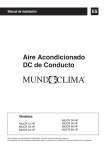

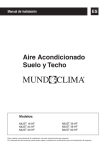

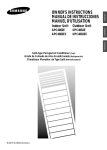
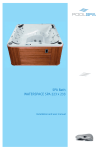
![HMBC[L]_Spanish_56571 [From English 54383].pub](http://vs1.manualzilla.com/store/data/006216602_1-cfe031224017a12fd1747226d4724f03-150x150.png)

